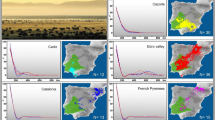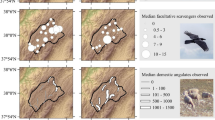Abstract
In many temperate ecosystems animal carcasses resultant from wildlife harvest can provide a high-quality food source for myriad facultative scavengers. We investigated scavenger use of human-provisioned ungulate carrion from a fall moose (Alces alces) hunt during 2010 and 2011 on the Gustavus Forelands, Alaska, USA. Using data from remote cameras, we (1) identified the scavenger species that used these resources and (2) evaluated their spatial and temporal responses to this seasonal resource event by indexing their activity patterns and relative order of arrival at carrion sites. We also quantified the length of time carrion persisted and estimated the amount of moose biomass provisioned to vertebrate scavengers by human hunters. Our results indicated that 11 vertebrate species (five birds and six mammals) scavenged moose carrion. We found that the common raven was the only species documented at all carrion sites and the most abundant species at moose carrion sites. As a species group, corvids [black-billed magpie (Pica hudsonia), common raven (Corvus corax); 0.1 ± 2.3 days] were the first to arrive at human-provisioned moose carrion sites, whereas ursids [brown bear (Ursus arctos), black bear (U. americanus); 1.3 ± 1.0 days] arrived after corvids but sooner than expected and canids [gray wolf (Canis lupus), coyote (C. latrans); 3.9 ± 3.0] arrived later than expected compared to our null model. On average, carrion persisted >20 days and hunters provided scavengers with a minimum of 2720 kg (82.7 kg/km2) and 1815 kg (64.8 kg/km2) of moose carrion during 2010 and 2011, respectively. Understanding how scavengers, particularly large carnivores, interact with human-provisioned moose carrion at the rural–wildland interface is essential for mitigating potential human–wildlife conflicts associated with humans subsidizing predators with a high-quality food resource.


Similar content being viewed by others
References
Beckmann JP, Berger J (2003) Rapid ecological and behavioral changes in carnivores: the response of black bears (Ursus americanus) to altered food. J Zool 261:207–212
Belant JL, Kielland K, Follmann EH, Adams LG (2006) Interspecific resource partitioning in sympatric ursids. Ecol Appl 16:2333–2343
Bolker BM (2008) Ecological models and data in R. Princeton University Press, Princeton
DeVault TL, Rhodes OE, Shivik JA (2003) Scavenging by vertebrates: behavioral, ecological, and evolutionary perspectives on important energy transfer pathway in terrestrial ecosystems. Oikos 102:225–234
DeVault TL, Olson ZH, Beasley JC, Rhodes OE (2011) Mesopredators dominate competition for carrion in an agricultural landscape. Basic Appl Ecol 12:268–274
Dormann CF, Elith J, Bacher S, Buchmann C, Carl G, Carré G, Marquéz JRG, Gruber B, Laforcade B, Leitão PJ, Münkemüller T, McClean C, Osborne PE, Reineking B, Schröder B, Skidmore AK, Zurell D, Lautenbach S (2013) Collinearity: a review of methods to deal with it and a simulation study evaluating their performance. Ecography 36:27–46
Gibeau ML, McTavish C (2009) Not-so-candid cameras: how to prevent camera traps from skewing animal behaviour. Wildl Prof 3:35–37
Haroldson MA, Schwartz CC, Cherry S, Moody DS (2004) Possibly effects of elk harvest on fall distribution of grizzly bears in the Greater Yellowstone Ecosystem. J Wildl Manage 68:129–137
Heinrich B (1988) Winter foraging at carcass by three sympatric corvids with emphasis on recruitment by the raven, (Corvus corax). Behav Ecol Sociobiol 23:141–156
Hilderbrand GV, Schwarts CC, Robbins CT, Jacoby ME, Hanley SM, Arthur SM, Servheen C (1999) The importance of meat, particularly salmon, to body size, population productivity, and conservation of North American brown bears. Can J Zool 77:132–138
Hilderbrand GV, Schwartz CC, Robbins CT, Hanley TA (2000) Effect of hibernation and reproductive status on body mass and condition of coastal brown bears. J Wildl Manage 64:178–183
Lafferty DJR, Belant JL, White KS, Womble JN, Morzillo AT (2014) Linking wolf diet to changes in marine and terrestrial prey species in a rapidly changing ecosystem. Arctic 67:143–148
Littell RC, Milliken GA, Stroup W, Wolfinger R, Schabenberger O (2006) SAS for mixed models, 2nd edn. SAS Institute Inc, Cary
Marzluff JM, Heinrich B, Marzluff CS (1996) Ravens roosts are mobile information centers. Anim Behav 51:89–103
Mateo-Tomás P, Olea PP, Moleón M, Vicente J, Botella F, Selva N, Viñuela J, Sánchez-Zapata JA (2015) From regional to global patterns in vertebrate scavenger communities subsidized by big game hunting. Biodivers Distrib 21:913–924
Meek PD, Ballard GA, Fleming PSJ, Schaefer M, Williams W, Falzon G (2014) Camera traps can be heard by animals. Plos One e110832
Meek PD, Ballard GA, Fleming PJ (2015) The pitfalls of wildlife camera trapping as a survey tool in Australia. Aust Mamm 37:13–22
Moleón M, Sáchez-Zapata JA, Selva N, Donázar JA, Owen-Smith N (2014) Inter-specific interactions linking predation and scavenging in terrestrial vertebrate assemblages. Biol Rev 89:1042–1054
National Park Service (2009) Bear Management Plan. Glacier Bay National Park and Preserve, Gustavus
Nelson RA, Folk GE, Pfeiffer EW, Craighead JJ, Jonkel CJ, Steiger DL (1983) Behavior, biochemistry, and hibernation in black, grizzly, and polar bears. Int Conf Bear Res Manage 5:282–290
Newton I, Davis PE, Davis JE (1982) Ravens and buzzards in relation to sheep-farming and forestry in Wales. J Appl Ecol 19:681–706
Oro D, Genovart M, Tavecchia G, Fowler MS, Martínez-Abraín A (2013) Ecological and evolutionary implications of food subsidies from humans. Ecol Lett 16:1501–1514
Pereire LM, Owen-Smith N, Moleón M (2014) Facultative predation and scavenging by mammalian carnivores: seasonal, regional and intra-guild comparisons. Mamm Rev 44:44–55
Pinjuv K (2013) Estimating black bear population size in Gustavus, Alaska: implications for determining the effect of human caused mortality on population size. Thesis, Evergreen State University
Selva N (2004) The role of scavenging in the predator community of Biołowieża Primeval Forest (E Poland). Dissertation, Polish Academy of Sciences and University of Sevilla
Stahler D, Heinrich B, Smith D (2002) Common ravens, Corvus corax, preferentially associate with gray wolves, Canis lupus, as a foraging strategy. Anim Behav 64:283–290
Streveler GP, Bosworth KZ, Christensen RE, Lentfer HP, Farley MC (2003) Gustavus plant communities, their composition, history, and use by fish, wildlife, and people. A report to The Nature Conservancy 28 p
Swenson JE, Alt KL, Eng RL (1986) Ecology of bald eagles in the Greater Yellowstone Ecosystem. Wildl Monogr 95:1–46
Titus K, Haynes TL, Paragi TF (2009) The importance of moose, caribou, deer, and small game in the diets of Alaskans. In: Watson RT, Fuller M, Pokras M, Hunt WG (eds) Ingestion of Lead from spend ammunition: implications for wildlife and humans. The Peregrine Fund, Boise, Idaho. doi:10.4080/ilsa.2009.0312
Trost C (1999) Black-billed magpie (Pica pica). In: Poole A, Gill F (eds) The Birds of North America, No 389. The Birds of North America Inc, Philadelphia, pp 1–28
United States Census Bureau (2010) Demographic Profile, Gustavus, AK. United States Department of Commerce. https://www.census.gov/popfinder/. Accessed 29 July 2014
White C (2005) Hunters ring dinner bell for ravens: experimental evidence of a unique foraging strategy. Ecology 86:1057–1060
White C (2006) Indirect effects of elk harvesting on ravens in Jackson Hole, Wyoming. J Wildl Manage 70:539–545
White KS, Barten NL, Crouse S, Crouse J (2014) Benefits of migration in relation to nutritional condition and predation risk in a partially migratory moose population. Ecology 95:225–237
Wilmers CC, Crabtree RL, Smith DW, Murphy KM, Getz WM (2003a) Trophic facilitation by introduced top predators: grey wolf subsidies to scavengers in Yellowstone National Park. J Anim Ecol 72:909–916
Wilmers CC, Stahler DR, Crabtree RL, Smith DW, Getz WM (2003b) Resource dispersion and consumer dominance: scavenging at wolf-and hunter-killed carcasses in Greater Yellowstone, USA. Ecol Lett 6:996–1003
Wilson EE, Wokovick EM (2011) Scavenging: how carnivores and carrion structure communities. Trends Ecol Evol 26:129–135
Acknowledgments
We thank the Alaska Department of Fish and Game for providing cameras, logistical and field support, particularly J. Jemison. We appreciated in-kind support provided by Glacier Bay National Park and Preserve. We thank A. Achey, M. Blakeslee, T. Lewis, E. Mount and G. Schmidt for field assistance. We thank the hunters in Gustavus for their enthusiastic participation. We appreciate constructive suggestions from J. Rivers during initial project planning. Financial assistance was provided by an Oregon State University (OSU) Diversity Advancement Pipeline Fellowship and an American Society of Mammalogists Grant-in-aid of research awarded to D.J.R. Lafferty.
Author information
Authors and Affiliations
Corresponding author
Rights and permissions
About this article
Cite this article
Lafferty, D.J.R., Loman, Z.G., White, K.S. et al. Moose (Alces alces) hunters subsidize the scavenger community in Alaska. Polar Biol 39, 639–647 (2016). https://doi.org/10.1007/s00300-015-1819-4
Received:
Revised:
Accepted:
Published:
Issue Date:
DOI: https://doi.org/10.1007/s00300-015-1819-4




